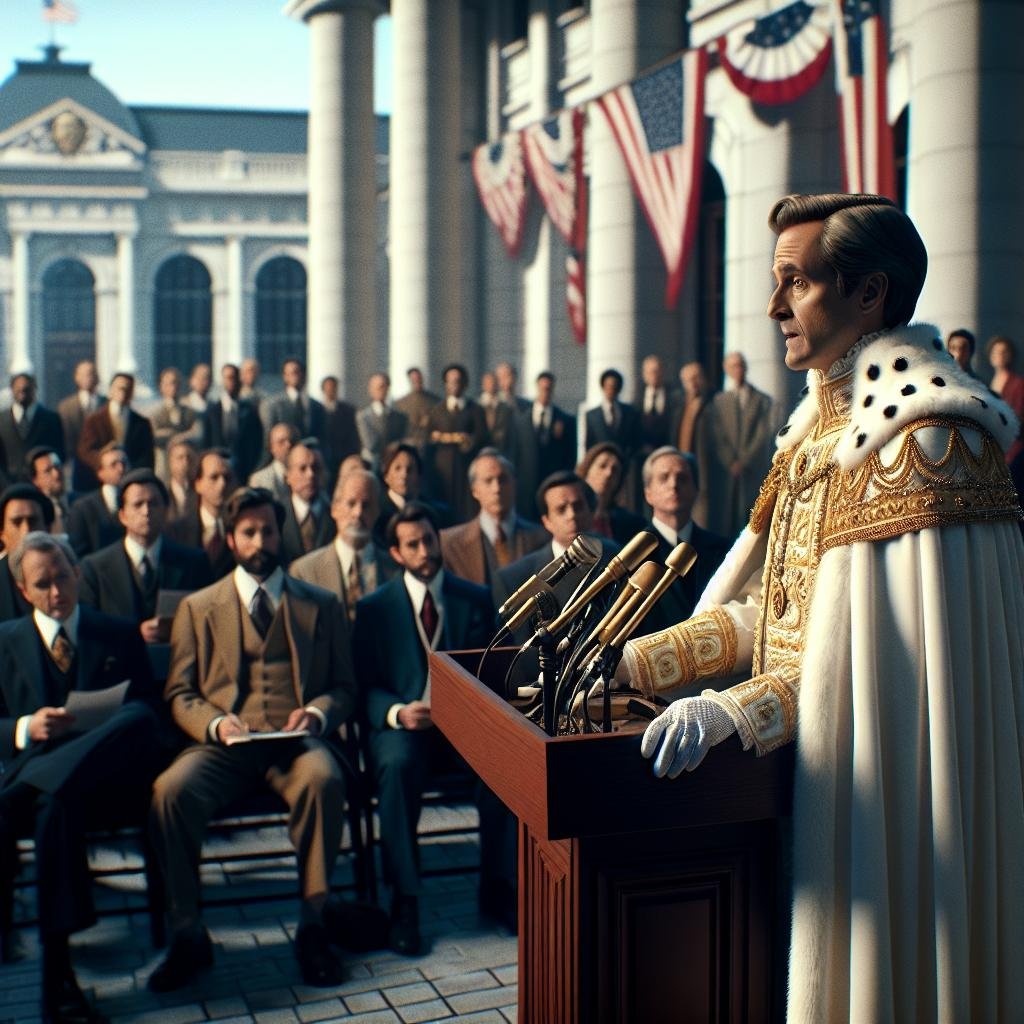
Trump Pope Image: Ultimate White House Reveal
The White House has generated significant buzz by posting an AI-generated image of former President Donald Trump dressed as the pope. This unusual image appeared on the White House’s official Truth Social account on Friday, depicting Trump wearing papal vestments including the distinctive white papal cap. The post quickly sparked conversations about the boundaries of political satire and the use of artificial intelligence in political messaging.
The Controversial Image and Its Context
The digitally altered image shows Trump wearing the traditional white outfit of the Catholic pontiff, complete with the zucchetto (white skullcap) typically worn by popes. This post emerged amid an already heated political climate as both Trump and Biden gear up for what promises to be a contentious 2024 presidential rematch.
White House officials confirmed the post was intentional, not the result of a hack or unauthorized access. Andrew Bates, a White House spokesperson, addressed media inquiries by stating the post was meant to highlight concerns about Trump’s authoritarian tendencies. According to Bates, the image was shared to draw attention to what Democrats characterize as Trump’s “dictatorial” ambitions should he return to office.
The timing is particularly notable as it coincides with renewed discussions about Trump’s previous statements regarding the consolidation of presidential power. In a March interview with Fox News, Trump had remarked about having significant authority “on day one” if re-elected, comments that his critics have pointed to as evidence of concerning intentions.
Political Reactions and Fallout
The image has predictably drawn strong reactions from across the political spectrum. Republican supporters of Trump have condemned the post as disrespectful, not only to the former president but also to Catholics and religious institutions. Several prominent Catholic leaders expressed dismay at what they perceive as mockery of their religious symbolism.
House Speaker Mike Johnson was quick to respond, calling the image “deeply offensive” and demanding its immediate removal. In a statement released shortly after the post appeared, Johnson emphasized that religious mockery has no place in official government communications.
“Using religious imagery for political attacks crosses a line that should never be approached by any government entity, let alone the White House,” Johnson said in his statement.
Meanwhile, Democratic strategists have offered mixed reactions, with some defending the post as legitimate political commentary and others questioning the wisdom of such provocative messaging from an official government account.
The Growing Role of AI in Political Messaging
This incident highlights the increasing presence of artificial intelligence in political communications. The clearly AI-generated nature of the image brings to the forefront concerns about how such technology might impact the 2024 election cycle.
Political analysts point out that this represents a new frontier in campaign tactics, where artificially created content can be deployed rapidly to make political points. The technology allows for the quick production of provocative visuals that might have previously required professional graphic design work.
“We’re entering uncharted territory with AI-generated content in political campaigns,” explains Dr. Eleanor Simmons, a political communication expert at Georgetown University. “The speed and ease with which these images can be created and distributed raises important questions about transparency and voter perception.”
The Federal Election Commission and other regulatory bodies have been wrestling with guidelines for AI use in political campaigns, though clear standards remain elusive.
Historical Context of Political Satire
While the use of AI might be new, political satire has deep roots in American political discourse. From political cartoons in early newspapers to television shows like “Saturday Night Live,” visual mockery of political figures has long been a feature of American political culture.
However, what makes this case unusual is that it comes from an official government account rather than a private media outlet or campaign. Historically, White House communications have generally maintained a more formal tone, even when criticizing political opponents.
Presidential historian Dr. Thomas Bellamy notes, “There’s certainly precedent for harsh rhetoric between presidents and their predecessors or challengers, but official White House channels have typically avoided this kind of visual mockery. It represents a departure from traditional norms of institutional communication.”
Real-World Example
Similar controversies have emerged in recent years as the boundaries between official communications and campaign messaging blur. In 2020, the Trump administration faced criticism when then-Secretary of State Mike Pompeo addressed the Republican National Convention from Jerusalem while on official diplomatic business, raising questions about the mixing of government functions and partisan politics.
These incidents reflect the increasingly blurred lines between government communication, campaign messaging, and personal political expression in the social media age – a trend that shows little sign of reversing as we head deeper into the 2024 election cycle.
Religious Implications and Catholic Response
The choice to depict Trump in papal garb has particularly resonated with Catholic voters, a crucial swing demographic in several battleground states. Catholic leaders across the country have expressed varying degrees of concern about the image.
Cardinal Timothy Dolan of New York, while not directly commenting on this specific incident, has previously emphasized the importance of respecting religious symbols across all faiths. “Religious imagery holds deep meaning for believers,” he stated in a recent interview about the general topic of religious mockery. “Using such symbols for political purposes risks trivializing what many consider sacred.”
Catholic voters themselves appear divided along partisan lines in their reactions, mirroring the broader political polarization in the country. Recent polling suggests that Catholic voters, like many religious demographics, increasingly align their political identities with their voting preferences rather than voting as a unified religious bloc.
White House Communications Strategy
This incident raises questions about the Biden administration’s communications strategy heading into the election. Political communication experts note that while the post certainly generated attention, it may not align with Biden’s frequent calls for greater civility in politics.
The White House has generally maintained a more traditional approach to communications compared to the Trump administration’s often unconventional social media presence. This departure has prompted speculation about whether it signals a shift in tactics as the campaign intensifies.
White House Communications Director Ben LaBolt has emphasized that the administration remains committed to fact-based messaging, though he did not directly address this specific post in recent comments. “Our focus continues to be communicating the president’s accomplishments and vision for the future,” LaBolt stated at a recent press briefing.
Social Media Platform Dynamics
The choice to post the image on Truth Social rather than more mainstream platforms like Twitter or Facebook adds another layer to the story. Truth Social, launched by Trump after his removal from other social media platforms following the January 6 Capitol riot, has become a hub for his supporters and right-leaning content.
The Biden administration’s decision to establish a presence on this platform represents an attempt to reach voters in spaces they might not typically encounter Democratic messaging. Social media strategists note this approach of “meeting voters where they are” has become increasingly common in modern campaigns.
However, the effectiveness of such cross-platform outreach remains debatable, as users of politically aligned social media often have strong pre-existing political preferences that are difficult to change through individual posts or images.
Legal and Ethical Considerations
Beyond the political implications, the incident raises questions about the legal and ethical boundaries of government communications. While political satire is protected by First Amendment freedoms, some legal experts question whether official government accounts should adhere to different standards than campaign accounts.
Government ethics experts point out that federal resources should generally not be used for campaign purposes, though the distinction becomes murky when discussing digital content that requires minimal resources to create and distribute.
“There’s a legitimate question about whether official government accounts should be used for content that appears primarily designed to influence an election rather than inform the public about government actions or policies,” notes Eliza Richardson, an ethics lawyer who previously worked in the Office of Government Ethics.
The Hatch Act, which restricts certain political activities by federal employees, contains exceptions for the president and vice president personally, but still applies to White House staff who might manage social media accounts.
The Path Forward
As campaign season intensifies, many political observers predict this type of provocative content will likely increase across all platforms. Both major parties have invested heavily in digital content creation, including exploring AI tools to enhance their messaging capabilities.
Media literacy experts emphasize the growing importance of critical consumption skills among voters. “Being able to identify AI-generated content and understand the context and source of political messaging will be crucial skills for voters in 2024,” says Dr. Marcos Rodriguez, director of the Center for Media Literacy at UCLA.
For the White House and the Trump campaign alike, the challenge will be balancing attention-grabbing content with messaging that effectively communicates substantive policy positions and vision to voters who may be increasingly fatigued by political noise.
Implications for Electoral Discourse
This incident serves as a preview of what many predict will be an extraordinarily contentious election cycle. With both candidates already having served as president, the personal animosity and policy differences are well-established and deeply entrenched.
Political scientists worry that focus on provocative imagery and personal attacks could further diminish substantive policy discussion. “When the discourse centers around provocative images rather than policy proposals, voters lose opportunities to make informed decisions based on how candidates would actually govern,” explains Dr. Sandra Martinez, political science professor at University of Michigan.
Polling consistently shows that while voters often claim to dislike negative campaigning, such tactics persist because they can be effective in motivating base voters and framing opponents in unfavorable terms.
Conclusion
The White House’s decision to post an AI-generated image of Donald Trump dressed as the pope represents a notable moment in an evolving political communications landscape. As artificial intelligence tools become more accessible and social media continues to reward provocative content, voters can likely expect more boundary-pushing visual messaging from all political actors.
The incident highlights tensions between traditional norms of government communication and the competitive demands of modern campaigning. It also underscores how religious imagery remains potent and potentially controversial when deployed in political contexts.
As both campaigns continue to refine their messaging strategies, this episode may well be remembered as an early indicator of how the 2024 presidential race would unfold in digital spaces, where the line between official communications, campaign rhetoric, and provocative content grows increasingly blurred.
Have thoughts about the use of religious imagery in political communication or the role of AI in campaign messaging? Share your perspective in the comments section below.


